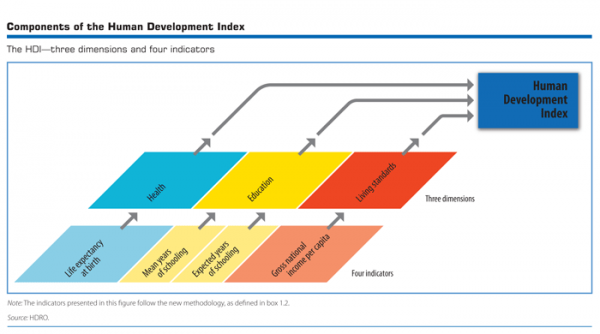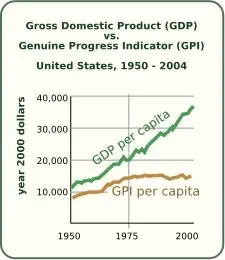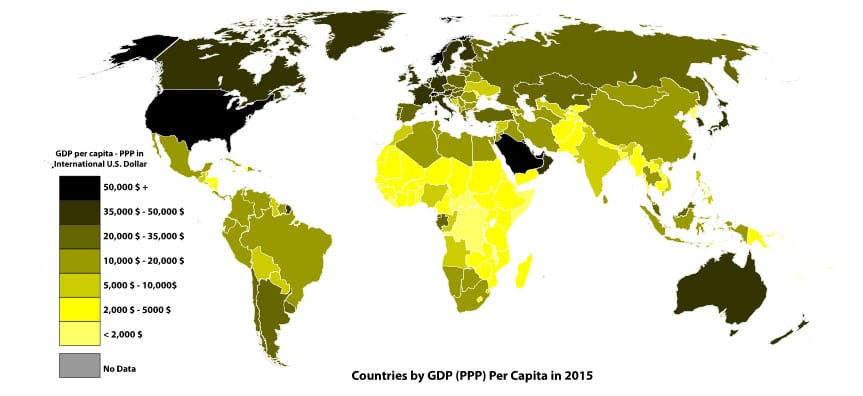What is Economic development?
Economic development is the process of improving economic welfare in an economy. Economic development can involve a stronger economy enabling a greater range of social services that improve a nation’s welfare. For example, an undeveloped economy will be primarily based on agriculture and very limited social services such as health care and education. Economic development involves an increase in real incomes, higher life expectancy, lower poverty and a greater provision of basic amenities.
Indicators of economic development
- Real GDP per capita – gross domestic product. The nation’s total economic output which is the same as a nation’s income.
- GDP at purchasing power parity (PPP) takes into account the local purchasing power of the currency and is a better guide to actual living standards.
- Levels of absolute poverty, e.g % of population with income less than minimum necessary to meet basic necessities of life.
- Malnutrition levels. Percentage of population with insufficient food – levels of malnutrition.
- Access to safe water. Percentage of population with access to safe water supply and sanitation
- Literacy rate – The percentage of a population that can read and write. Also consider gender discrepancy.
- Mean years of education – Length of education gives indication on deeper education standards.
- Number of doctors per 1,000 of population.
- Average life expectancy. Life expectancy generally rises with economic development.
- Openness of economy to international trade. Also, levels of foreign direct investment.
- Quality of nation’s infrastructure – quantity and quality of roads, railways and airports.
- Share of agriculture in economy. Over 90% indicates an undeveloped economy. Less than 10% of economy in agriculture suggests more developed economy.
- Political stability and security.
- Wildlife Diversity
Specific Measures of economic development
1. Human Development Index (HDI)
- Life Expectancy Index. Average life expectancy compared to a global expected life expectancy.
- Education Index
- mean years of schooling
- expected years of schooling
- Income Index (GNI at PPP)

2. Index of Human Poverty HPI
The human poverty index (HPI) was introduced by UN Development Programme (UNDP)
To measure rates of economic development for low-income countries it examines education, life expectancy, rates of absolute poverty and access to health care and safe drinking water.
(HPI-1) It involves combining
- Probability at birth of not surviving to age 40 (times 100)
- Adult illiteracy rate
- Arithmetic average of these three characteristics:
- The percentage of the population without access to safe water.
- The percentage of population without access to health services.
- The percentage of malnourished children under five.
3. Genuine Progress Indicator (GPI)
The GPI seeks to take a more accurate account of a nation’s well being than just GDP (gross domestic product). GPI starts with GDP as its base but also takes into account environmental and social factors such as
- Pollution
- Poverty rates
- Health standards
- Inequality rates
- Crime rates
- Cost of pollution abatement
- Cost of commuting
- Cost of road accidents
- Value of education
- Value of housework and parenting
The GPI Suggests that as economies gain increased GDP, economic welfare generally increases, however, there comes a point where GPI starts to grow more slowly and eventually stagnate. In other words, higher GDP does not automatically lead to economic development because the costs of growth become as high as the benefits.

Evaluation
Some indicators of economic development are fairly straightforward
- Poverty reduction
- Increased levels of education
- Increased provision of health care
- Increased life expectancy.
However, some measures may be more controversial. For example, building an airport would generally be seen as economic development, however, if GPI is used to measure, the benefits of air travel may be offset by carbon emission, noise from airports and congestion in cities.
Related
- Policies for Economic Development
- Factors affecting economic development
- Difference between economic growth and development
Published 21 May 2020, Tejvan Pettinger. www.economicshelp.org

